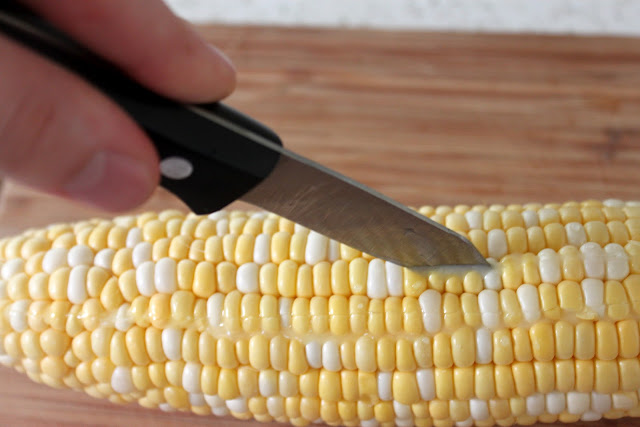There's nothing that says summer quite like corn. Corn on the cob, scorched with grill marks, dripping with butter. Husks that remind me of bark stripped off a tree. Corn silk that seems to get stuck everywhere, from your teeth to the counter where you've been working.
And isn't it a beautiful vegetable? Just right for late-afternoon photo shoots.
I've written about my love of cornbread before, but this time it's all about straight-up corn, before it's been ground into meal. This is a different kind of love, friends.
Really, it makes sense that we'd come across corn sooner or later. There's so much historical weight attached to corn. It was the crop that Squanto taught the Pilgrims how to plant after a particularly harsh first winter. Native Americans traditionally grew maize, squash, and beans together as the Three Sisters crops. And apparently it was also the crop that saved the lives of the first Virginians (once they stopped being stubborn and decided to learn how to farm). Plus, corn is native to North America, so it was a revolutionary crop to those European colonists.
So why couldn't the colonial Virginians come up with a better way of serving corn?
It's a promising recipe. "Take six large, tender, milky Ears of Corn. Split the Corn down the Center of each Row; cut off the Top and then scrape the Cob well." I dare you not to steal a few pieces of corn once you've cut it off the cob. Then you mix it up with flour, salt and pepper, eggs, and milk, and bake it into a steaming pudding. When it comes out of the oven, brown and bubbling from the butter you put on top, it's hard not to dig right in. You eagerly anticipate that first taste.
When I was young, sometimes we would have microwaveable meals for dinner. Lean Cuisine chicken marsala, Stouffer's creamed spinach. Sometimes my parents just wanted to round out the meal, so they'd heat up a packaged side dish. That's fine. Sometimes it's all you can manage.
One of the dishes in regular microwave rotation was Stouffer's corn souffle. It was kind of a spongy pudding made with corn, light and airy. And guess what, friends.
I've replicated that corn souffle. Except instead of the 15 minutes it took to heat up the plastic container, this took a good 1 1/2 hours. And a historical cookbook.
It's not to say that this is a bad corn souffle. It's light and airy and corny and accompanies other dishes quite well. But as Josh so eloquently put it, it's like "corn with mush in between," a cross between straight-up corn and cornbread. We both would have preferred to eat one or the other.
So, because it seems worth it to start a tally:
historical corn recipes: 0
dashed culinary expectations: 2
Maybe I just need to stop expecting so much from corn. It's just a vegetable, after all.
Corn Pudding
(adapted from The Williamsburg Art of Cookery)
4 ears of corn
2 eggs
1/4 cup flour
1 1/2 cups milk
salt and pepper, to taste
2 tbsp butter, cubed
Preheat the oven to 350 F.
Shuck the corn and slice each row down the middle (it doesn't take as long as it sounds, but you will get splashed). Slice the kernels off the cob. It's okay if you don't get the whole kernel in one go. Put all the sliced corn into a large bowl.
Beat the eggs together in a separate bowl and mix with the sliced corn. Add the flour, milk, and a dash of salt and pepper. Beat to combine.
Grease a souffle dish (or an oven-safe dish that's about 4 inches deep). Pour in the pudding mixture, and top with dots of the butter. Bake for 60 - 75 minutes, or until the pudding is puffed, brown, and bubbling on top.


























